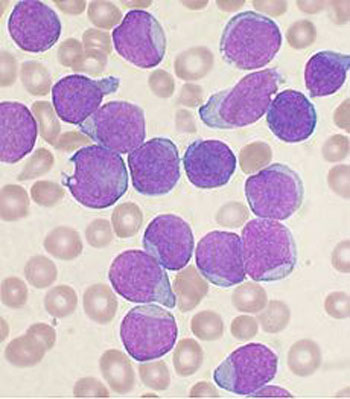Fusion Circular RNAs May Be Linked to Leukemia
By LabMedica International staff writers
Posted on 12 Apr 2016
The activity of noncoding circular RNAs has been linked to the development of leukemia and other cancers.Posted on 12 Apr 2016
Chromosomal translocations result in the production of oncogenic fusion proteins that are involved in tumor formation. Whether such genomic alterations also affect noncoding RNAs is unclear, and their impact on circular RNAs (circRNAs) has not been rigorously examined.

Image: A bone marrow aspirate smear showing precursor B-cell acute lymphoblastic leukemia cells. Chromosomal translocations and gene fusions are common in various types of leukemia (Photo courtesy of Wikimedia Commons).
Investigators at Beth Israel Deaconess Medical Center (Boston, MA, USA) reported in the March 31, 2016, online edition of the journal Cell that well-established cancer-associated chromosomal translocations gave rise to fusion circRNAs (f-circRNA) that were produced from transcribed exons of distinct genes affected by the translocations. F-circRNAs contributed to cellular transformation, promoted cell viability, and resistance upon therapy and had tumor-promoting properties in animal models.
As chromosomal translocations are common in various types of leukemia, the investigators examined acute promyelocytic leukemia cells, which often carry a translocation between the PML (Promyelocytic leukemia protein) and RAR-alpha (Retinoic acid receptor alpha) genes and acute myeloid leukemia cells, which can harbor a translocation between the MLL (Histone-lysine N-methyltransferase 2A) and AF9 (myeloid/lymphoid or mixed-lineage leukemia; translocated to, 3) genes.
They found abnormal fusion-circular RNAs (f-circRNAs), corresponding to different exons associated with the PML-RAR-alpha gene fusion as well as the MLL-AF9 gene fusion.
Experiments were conducted in a mouse leukemia model that focused on a specific f-circRNA (f-circM9) associated with the MLL-AF9 fusion gene. Results indicated that the activity of f-circM9 in conjunction with other cancer-promoting signals could trigger the disease.
"Cancer is essentially a disease of mutated or broken genes, so that motivated us to examine whether circular RNAs, like proteins, can be affected by these chromosomal breaks," said senior author Dr. Pier Paolo Pandolfi, professor of medicine at Beth Israel Deaconess Medical Center. "These results are particularly exciting because they suggest that drugs directed at fusion-circular RNAs could be a powerful strategy to pursue for future therapeutic development in cancer. Our work paves the way to discovering many more of these unusual RNAs and how they contribute to cancer, which could reveal new mechanisms and druggable pathways involved in tumor progression."
Related Links:
Beth Israel Deaconess Medical Center













